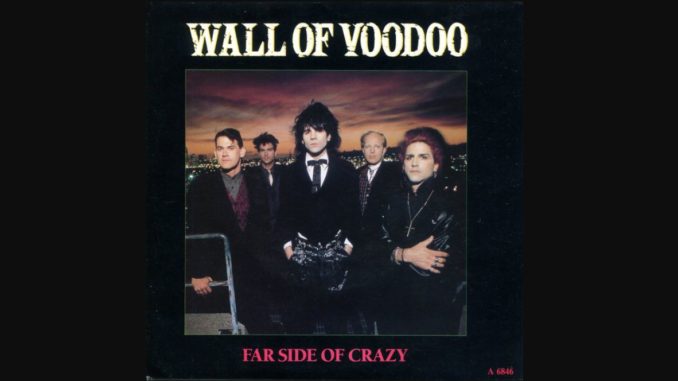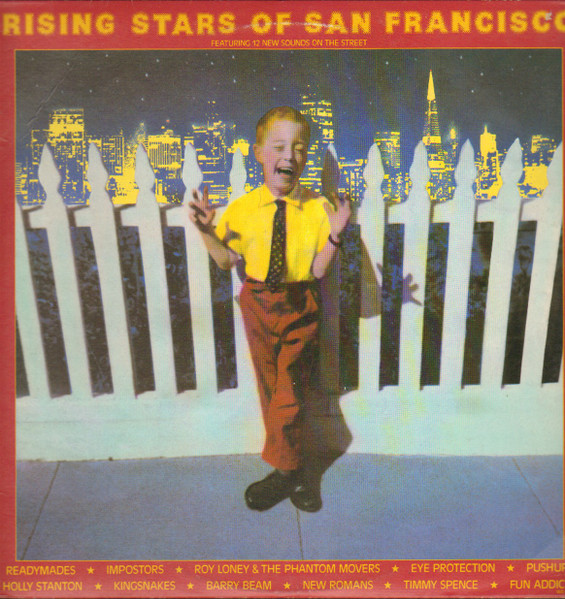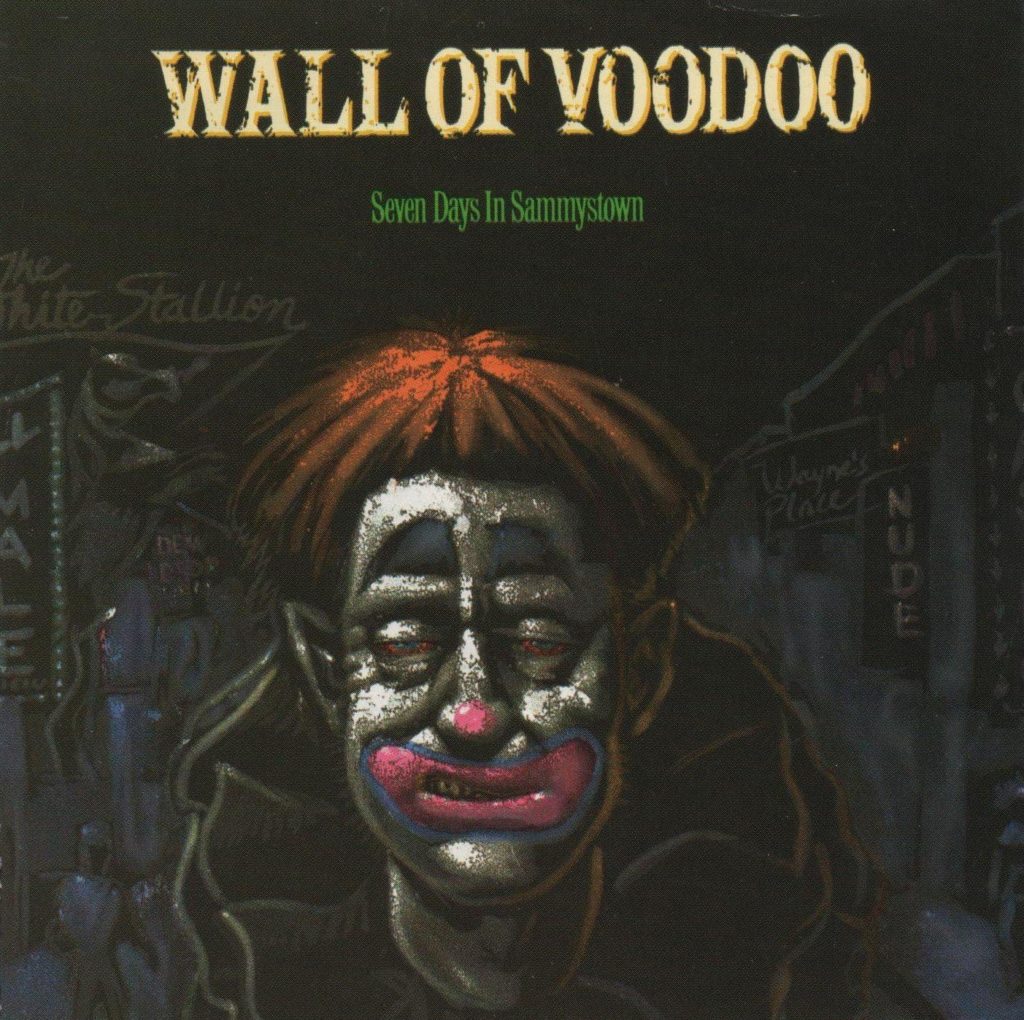
Wall of Voodoo is a band of two distinct eras, defined by their frontmen: the Stan Ridgway years (1977-1983), and the Andy Prieboy years (1984-1988).
There were other differences between these versions of the band as well, but also several commonalities. One commonality was that both versions of Wall of Voodoo had merit, always making excellent and somewhat eclectic music and putting on entertaining shows.
The fact that two distinct eras exist has led to the perception that fans are divided into camps who will only like one version of the band. In some cases that is probably true, but it would be more common for fans to have a preference for either the Ridgway or the Prieboy era while also enjoying the other one.
Originally formed in Los Angeles, the original Wall of Voodoo line-up made an indelible impression during the early 1980s with their clattering, off-kilter, experimental songs. After a swift upward career trajectory, which saw them getting a US hit single with Mexican Radio, the future seemed bright for the band. Unfortunately, things fell apart shortly after.
The band’s performance at the US Festival on 28 May 1983 saw them on the cusp of a mainstream breakthrough. It was the largest concert the band had performed, the band delivered a great performance, the crowd loved them, and it really did look like Wall of Voodoo had arrived at the next level. People were embracing them and had high hopes for what the band would unveil next.
As it turned out, there nearly was no ‘next’. Wall of Voodoo were falling apart, and the fired-up performance may have partially been because they (at least some of them) knew it was the last hurrah.
Immediately following the US Festival, their frontman Stan Ridgway left the band, as did Joe Nanini (drums) and Bill Noland (keyboards). Ridgway has stated that the situation around the band was increasingly chaotic during this time, with a great deal of drug use and out-of-control behaviour on the part of the band members, as well as shady behaviour by the band’s management and record label. Shortly after, Ridgway embarked on a successful solo career.
RELATED STORY: The story behind the song «Camouflage» by Stan Ridgway
This left the depleted line-up of Marc Moreland (guitar) and Chas T. Gray (keyboards, bass) to make up their minds about the future. They decided to rebuild, which started with convincing Marc’s brother Bruce Moreland (bass) to return to the band after having first left in 1982. Ned Leukhardt also joined as a new drummer.
The frontman position proved to be a lot harder to fill. Ridgway had been a very distinctive and unique performer, and while they were certainly not looking for a clone, they wanted someone special.
It wasn’t until mid-1984 that Andy Prieboy came into the picture. The story goes that after months of frustration, a very drunk Bruce Moreland met Prieboy at a party and recruited him immediately on the basis of his looks.

As it happened, Prieboy was a musician as well as a songwriter. He had previously fronted the San Francisco new wave band Eye Protection. Their whole musical output was limited to a single in 1979, as well as a track on Rising Stars of San Francisco – a compilation album featuring local, unsigned acts. The latter featured Prieboy’s track Take Her Where the Boys Are which became a local hit in 1981.
Some years later, Prieboy had relocated to Los Angeles after signing a production deal. It was not leading anywhere, so he found himself in Hollywood needing to work.
In 2019, on the Green Hour with Dan and Jerry podcast, Prieboy talked about that time and added a few details about his encounter with Bruce Moreland: “I got a day gig selling toys at this place called Soap Plant, and across the street from me was a punk rock clotherie called Poseur where all the punk rock kids went. While I’m working selling toys, I would see this gothy kind of guy walking in and out of it. That’s all I knew. I went to a party one night, and he was there – this gothy guy. I just knew him as the guy who worked across the street from me. We were sitting there shooting the shit about work, about working on Melrose – you know, like people do. And this drunk guy waddles up to us, looks at me, and then looks at this guy I’m talking to, and says to him while pointing at me: ‘This is the guy you’re looking for!’ Then the guy looks at me and says, ‘Can you sing?’ I went, ‘Yeah, I sing. Do you play an instrument?’ ‘Yeah, I play bass.’ Then I asked, ‘What’s the name of your band?’ And I had him pegged for some goth shit. But then he says, ‘Wall of Voodoo’, and that’s when the drunk guy added ‘…and you’re the guy they’re looking for!’ So the ice was broken!”
The subject had been broached, and they ended up talking a bit more. Moreland requested a tape that he could bring back to the others. These developments were incredible to Prieboy, who also said “If I was gonna ever join a band, that would be the band I’d want to join! I had to ask if the risk of failing was worth it, because Stan Ridgway is a formidable frontman. […] I knew Wall of Voodoo was looking for a singer, but I wasn’t gonna go out for that. I thought, I’m not gonna stand in Stan Ridgway’s place! And then all of a sudden, through this serendipitous, drunk exchange, I ended up talking to Bruce [about it].”
Things moved quickly from there. A demo tape changed hands, and a few days later he met Bruce again, as well as his brother Marc for the first time. They had really liked the tape – especially one particular song on it called Far Side of Crazy which proved that Prieboy was able to come up with significant contributions on the songwriting front.
I’m Pilate and Jesus and I wept when Lennon died
Yet I envied his assailant when I visited the shrine
I cried for all those Beatle Fans so old so quick they grow
I follow the example to destroy what I love mostAnd I remain on the far side of crazy
I remain the mortal enemy of man
No hundred dollar cure will save me
Can’t stay a boy in no man’s land
The lyrics of the song took inspiration from the poems created by John Hinckley Jr., who attempted to assassinate U.S. President Ronald Reagan in 1981 and ended up injuring him as well as several security guards before he was apprehended. Parts of the lyrics go, “I shot an actor for an actress but he lived to make a joke / Shot two other men who could have been the bodies of my folks”.
Hinckley was obsessing over actress Jodie Foster. After stalking her for some time, he started believing that the only way to attract her attention was to become famous himself. He was inspired by the murder of John Lennon and the subsequent media attention that his killer, Mark David Chapman, received as a result.
The song picks a number of lines from the poem-filled letters that Hinckley sent to Foster both before and after the assassination. The song’s title comes directly from a stanza in one of them; he wrote “I remain the far side of crazy” some time before he shot President Reagan. “Maybe I’m the quiet psychopathic type,” he mused in another. “Satan’s long-lost illegitimate son,” he called himself in a third. “Inside this mind of mine, I commit front page murder, I think of words that could alter history,” Hinckley scrawled in a fourth poem, as well as “Inside this mind of mine, demons do the boogie woogie.”
I once hid my lust for stardom like a filthy magazine
I stroked the shaft on my guitar and watched you on the screen
I’ve become now what I wanted to be all along
A psychopathic poet the Devil’s bastard son
It wasn’t happy subject material, but Wall of Voodoo did not necessarily deal with happy subjects. The band was more than happy to have a frontman who not only looked the part, but who could sing and write such phenomenal songs as well. There was no question: the new line-up of Wall of Voodoo was complete.
They started hanging out together, putting together the ideas they had and shaping them into songs, which included figuring out and defining what the new version of the band would sound like. They would keep one leg in their past, but the other one firmly planted in the future.
When they were ready, the band went to England to record a new album. It was produced by Ian Broudie from the Lightning Seeds, who was an in-demand producer. His production discography includes albums by Echo & the Bunnymen, Icicle Works, Richard Jobson, the Fall, Alison Moyet, the Coral, the Primitives, and dozens more. He was happy to be asked, as he happened to be a big Wall of Voodoo fan.
The album was recorded at Amazon studios in Liverpool, where Broudie was based, as well as Konk studios in London, owned by Ray Davies of The Kinks.
Broudie concentrated on giving the album a slickly, good-sounding, layered production sound. They made a conscious choice to move away from the more experimental material of their early albums, while retaining and expanding on the cinematic qualities they were known for. The songs the band had come up with were strong, and it was felt they should be allowed to shine. There was no need to hide them under strange sounds or rougher, low-fi stylings.
Shades of the band that had been could be found in Far Side of Crazy’s intro section, where Marc Moreland’s western-y, twangy guitar line takes centre stage. Then a thundering bass beat from Bruce Moreland stomps in. Prieboy then took the role of the psychopathic, obsessed poet beautifully.

The stellar Seven Days In Sammystown was released on 15 July 1985. Prieboy ended up contributing several songs to the album. In addition to everybody’s early favourite Far Side of Crazy, he brought in Room With A View and the other album highlight Blackboard Sky. All five members of the band were contributing songs, but Prieboy’s material was liked by all, with the band rallying around Far Side of Crazy in particular. It didn’t take much discussion for them to decide that this would be the album’s single.
Far Side of Crazy was released as the album’s lead single a few months later, in October 1985. The accompanying music video presented a mournful Sammy the Clown (the character depicted on the album’s front cover) videotaping the group, looking like stylish rogue-rock-and-roll-western-dandies as they kick around a dusty Wild West and an urban street with a cast of dancing extras.
The single unfortunately failed to chart everywhere – except in Australia! It proved to be a real slowburn hit, taking two months to chart after first being released in January 1986. Australian superfan Andy Inkster revealed that it first entered the charts on 10 March 1986, and managed to stay in the top 100 for 21 weeks, peaking at #23 in July. “It was played heaps on the radio,” he enthusiastically yet nostalgically recalls, before adding a very understated “I liked it quite a lot.”
The Australian single success gave extended chart life to the album as well. Just like the single it never got any high chart peaks, but survived in the lower end of the charts for some time with #50 as the highest placement. The band managed to build a firm and loyal fanbase in Australia during this time.
Far Side of Crazy also got some wider visibility by being featured in the 1985 movie Head Office. The band also contributed Deep In the Jungle to John Hughes’ popular teen movie Weird Science. Having tracks in movies gave them some levels of visibility, but sadly did not contribute much in the way of further chart success.
Superfan Andy Inkster can at the very least confirm that the success the band saw in Australia was a lasting one: “Far Side of Crazy was, and continues to be, a radio staple in Australia! Our premier rock station 3MMM still has the song on its roster and I still hear it from time to time. If you ask most Aussies of similar vintage to me, they would most definitely know it.”
If the rest of the world had felt similarly to Australia, perhaps the second era of Wall of Voodoo would have had more longevity. As it happened, it didn’t. After a further studio album with Prieboy (1987’s Happy Planet), the band called it quits in 1988. Their final farewell was the live album The Ugly Americans, released in 1989 (recorded a few years earlier). It had, of course, been recorded live in Australia.

Facebook Comments